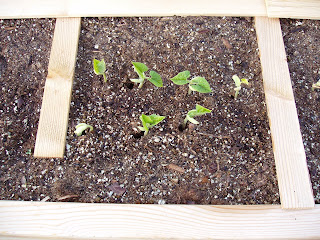After a few weeks of neglecting the garden, it's time to pay the piper. Actually, I'm thinking this story began early in the season with all the rain we got. I didn't control the weeds adequately and they turned out to be quite the living space for an unbelievable crop of grasshoppers. I wish I could convey how bad they've been this year. There are literally scores of them jumping away from me as I walk down the paths in the garden. The boys and I have tried on several occasions to scare them into the area the chickens roam, but we've hardly made a dent.
They have stripped almost all the beans down to the stems,

decimated the corn and potatoes,

and have done serious damage to the cabbage.

They have even eaten the onion tops down to the ground. I didn't even know grasshoppers would eat onions.

And every ripe tomato gets attacked before we even know it's ready.

When I wandered through the garden today, I got mad. I took out some of my frustration tearing down the dead pea vines, uprooting some corn and beans and squashing with my bare hands any grasshoppers unlucky enough to get caught. Pretty nasty. It was enough to bring me to the verge of tears. I was ready to throw in the towel. As I stewed and fretted, I thought about the experiences the pioneers had when they came to these valleys and had their crops overrun by insects. I don't depend on my garden to sustain my family, so I can't imagine what kind of frustration and fear the pioneers felt as they watched their crops destroyed. Maybe I got a little taste today. We should definitely revere those men and women who settled the west and endured so much hardship.
On the bright side, my hot peppers and melons seem to be doing well.


And the potatoes look like they got big enough to use before the tops were wiped out.

All these grasshoppers have put a serious damper on my fall-crop plans. I need to figure out some way to protect the young plants I'm ready to put out.
The dog days of summer are nearly upon us. It's one of the hardest seasons for me to garden in, whether due to bugs, disease, weather or apathy. Keep your shoulder to the wheel!
































